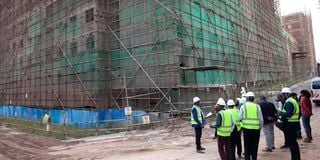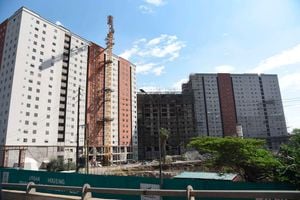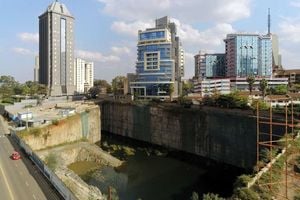
Construction at Jeevanjee Estate Project in Ngara, Nairobi on November 4, 2024.
Once upon a time, in the days before Mwai Kibaki became president, land sharks had descended on Nairobi’s Processional Way — the grand avenue that wove from State House Road to Nyerere Road by Nairobi’s Serena Hotel. This public road, meant for the people, had mysteriously slipped into private hands. Title deeds had been signed, sealed, and delivered, transforming a public pathway into privately owned parcels of land.
It was Amos Kimunya, then the Minister of Lands, who dared to reclaim it. Backed by Kibaki, he stood firm. It was revealed that the road had been carved up into eleven parcels, each with its own title deed. Parliament listened intently as Kimunya explained that some titles had even found their way into banks as collateral. Determined to uphold public trust, the Kibaki government called for the return of these titles — then in the hands of some Kanu mandarins, who are today in power. In 2009, Kimunya would look back on those tense days, recalling how he had warned the banks that, while they could auction the road to recoup their loans, he doubted there would be many eager buyers for what was, in truth, a public road.
This story resurfaces because the same ominous patterns appear to be gathering anew. Once more, our public properties — our collective heritage — find themselves in peril. Under the pretext of “affordable housing,” historic sites and communal spaces are quietly slipping into private hands, disappearing into the coffers of profiteers and land speculators. Consider Jeevanjee Estate, Nairobi’s historical housing site, whose worth lies not only in its heritage but in its potential as a beacon of cultural tourism. Around the world, cities protect their old housing estates as cherished monuments, valuing them as living links to the past. Today, we are told that the developer has used this public property to take a bank loan.
Nairobi has over the years managed to erase its history since we do not have a department in charge of heritage within City Hall. Heritage management has been left to the poorly funded National Museums of Kenya, and while the national government has the mandate to oversee “ancient and historical monuments of national importance” — as per the 2010 constitution — the devolved museums, and we need proper discussion on these, should make sure that county heritage sites are not interfered with.
That is why we complain when we witness history of a nation, or of a county brought down by tractors. In Nairobi, we recently lost Tom Mboya Hall, the vibrant hub of political and trade union activism from the 1950s. Its demolition, as I argued, was not only an assault on the memory of Tom Mboya but also an erasure of history closely tied to Kenya’s fight for independence. Just as we’ve preserved Karen Blixen’s legacy, we must ensure that African historical sites remain intact—a testament to our own past, not merely a developer’s playground.
In the Moi era, an audacious attempt emerged to seize Nairobi’s cherished Jeevanjee Gardens and transform it into an underground parking lot. But Zarina Patel, the unwavering granddaughter of A.M. Jeevanjee, rose to the occasion, defending the gardens with an unyielding spirit that echoed Wangari Maathai’s iconic stand for Uhuru Park. Maathai, after all, had famously thwarted Moi’s grandiose plans to erect the Kenya Times towers upon that beloved green space.
We also recall the attempts made to grab Karura Forest and had activists not stepped in, we could have, by now, lost the entire forest. The story of land grabbing, the turning of public spaces into private, illustrates our appetite for sleaze and bad manners. Around the same time in 1991, yet another land-grab scheme surfaced, this time targeting the Kenya National Theatre parking lot. The neighbouring Norfolk Hotel had its sights set on annexing the space, but thespians, resolute and defiant, safeguarded the land against encroachment in the name of “business.”
Zarina Patel’s battle is a potent reminder that our public spaces hold more than mere land value; they enshrine pieces of our shared history, collective memory, and cultural identity. These are sites to be preserved with reverence, perhaps even as hallowed grounds, akin to marking graves. Consider, for instance, the unmarked former headquarters of the Kenya African Union (KAU), which once housed Jomo Kenyatta himself.
Colonial ceremony
Today, his historic office on the first floor of Kiburi House has been transformed into a hardware store — a lamentable fate for a space of such profound significance. Shiraz Durani’s Never Be Silent vividly portrays Kiburi House as “the heart of progressive political and trade union activity in the country.”
This building, he notes, became a nucleus for anti-colonial fervour, where clandestine plans for strikes, resistance meetings, and other activities circulated swiftly across the nation. Here, Mau Mau cadres turned Kiburi House into a beacon of working-class strength, defiance, and covert resistance — right at the heart of Nairobi.
But Kiburi House hardly features in the history of our nation as the pioneer building where trade union was born. It was in Kiburi House that pioneer unions found a safe haven. Here, plans were drawn, strategies forged, and solidarity nurtured. It was the birthplace of Bildad Kaggia’s Clerks and Commercial Workers’ Union, Markan Singh’s Labour Trade Union Congress of East Africa, and Fred Kubai’s Transport and Allied Workers’ Union. In preserving spaces like these, we honour their legacies — places steeped in the spirit of liberation, defiance, and the unbreakable will of Kenya’s freedom fighters.
Allow me to touch upon yet another haunting site of neglect: The Macmillan Memorial Library. If you haven’t visited lately, do yourself a favour—step inside. Built as a tribute by Lady Macmillan in honour of her husband, Northrup Macmillan, a rancher whose holdings spanned from Juja Farm to Kilimambogo, this library was her gift to the people of Nairobi, a repository of knowledge and history intended to endure through generations. Within its walls lie Kenya’s rarest newspapers, some dating back as early as 1903 — treasures found nowhere else in the nation. Rare books once graced its shelves, archives chronicling stories of Kenya’s past, preserved with care over the decades. But today, Macmillan Library teeters on the brink of oblivion, and I write this with an urgent appeal: we are on the verge of losing this historical sanctuary.
To Johnson Sakaja, I implore you — make the journey to Macmillan Library. Ask to see the basement, where these irreplaceable works are hidden away. Witness firsthand the tragedy unfolding: shelves stripped bare, newspapers crumbling into dust, and an eerie lack of seating where readers once gathered. Nairobi’s very memory is being stripped away, eroded day by day. Even the iconic ivory tusks flanking its entrance may one day vanish. The Macmillan Library is no ordinary building; it is a vessel of our heritage, one that deserves care, respect, and preservation. To lose it would be to rob Nairobi — and Kenya — of a priceless chapter of its soul.
Heritage deserves a more celebrated place in our landscape. Take, for instance, Homa Bay — the first town ever planned in Kenya. In the colonial 1950s, its foundation stone was laid with pomp and grandeur, marking a historic milestone.
Imagine the spectacle of that opening event, rich with colonial ceremony. If Homa Bay County truly values its heritage, it must hold tight to this memory. Such sites should never fade into obscurity, for they bear witness to the town’s unique story. Preserving these landmarks has immense potential; when history remembers Homa Bay or any other Kenyan town, these sites could draw tourists just as we, in awe, journey to explore the historic towns of other nations.
But do grabbers think this way?
@johnkamau1













